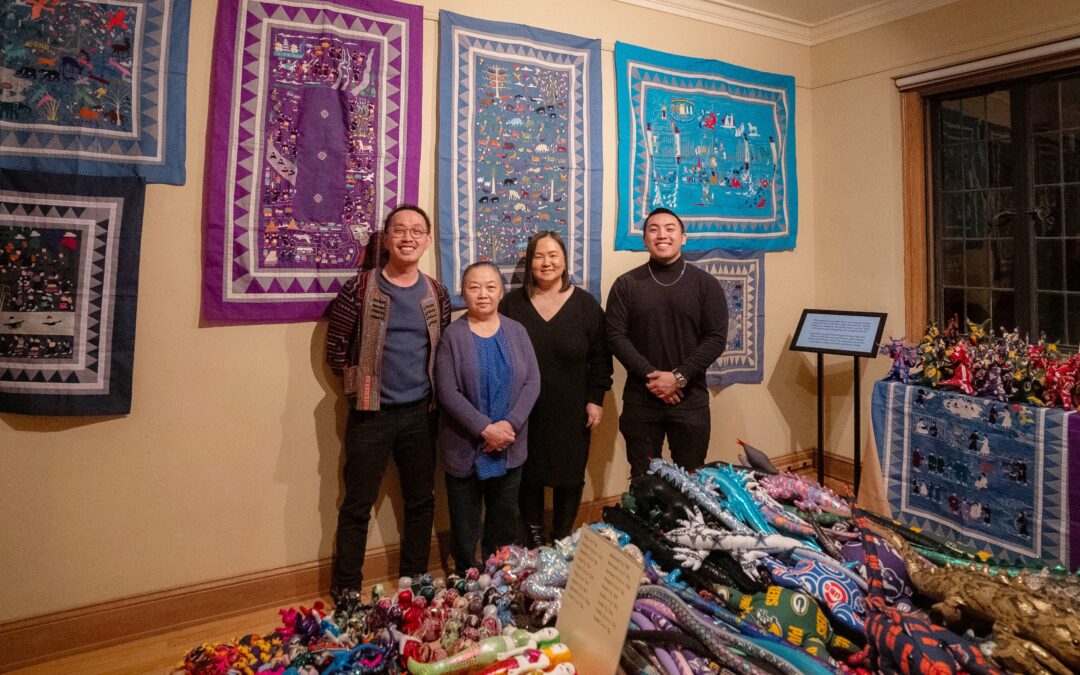Two UW Oshkosh faculty members helped create an important exhibition featuring the first Hmong solo artist in the historic Paine Arts Center and Gardens.

Chong Moua, left, and Choua Xiong pose in front of artist Mao Lor’s photo and story.
Chong Ntxoo Moua, assistant professor of UWO Hmong Studies, co-curated Mao Lor: A Journey through Hmoob Paj Ntaub, an exhibition that showcases more than two dozen of Lor’s hand-sewn and embroidered artwork, and Choua Xiong, assistant professor of Hmong Studies, helped develop and coordinate the K-12 curriculum for students who visit the exhibit.
Moua and Xiong said that the exhibition is more than just another art installation because of its historical significance.
“I was happily emotional and very proud of all the work we put in,” said Moua, who worked with co-curator and artist Ger Xiong/Ntxawg Xyooj. “I got all the feels because it was so amazing to see Hmong art occupy the gallery space. We were able to turn that gallery, which most recently hosted Rodin sculptures, into a Hmong space. That contrast is not lost on me.”
Moua was born in Laos before her family fled to Thailand. Her family came to the U.S. as refugees in 1989 and settled in California where she grew up. Xiong, born in Ban Vinai Refugee Camp in Thailand, grew up in Appleton.
“Hmong art is historically not seen as having the history and/or value of some pieces that have previously been featured at the Paine, but this exhibition definitely demystifies those dominant ideas,” Xiong said. “My hopes are that people can reorient themselves to see and recognize Hmong artists as valuable knowledge producers and contributors to their own lives. Hmong people are not just victims of the Secret War or worthy of recognition because they ‘helped’ Americans during the Vietnam War.”
In this video, Chong Moua and Choua Xiong talk about the value of showcasing Hmong art in prominent spaces:
Xiong said Lor’s work tells stories of the Hmong people other than those associated with war. “The works shown in this exhibition…featuring Mao’s life and her craft does not focus on the Secret War, but that Hmong paj ntaub has always existed before Americans encountered Hmong people,” Xiong said. “Thus, this exhibit does not exoticize Hmong people in the Fox Valley but recognizes that Hmong talent is a norm in the Fox Valley. By featuring Mao, we get to name and associate Hmong textile with an artist rather than a faceless, nameless Hmong person.”
Moua added that the exhibit is a celebration of people in the community.
“One thing I love about this exhibit is that it’s both a Hmong story and also a very local Fox Valley story,” she said. “It shows the vibrancy of both and how both stories can be told and celebrated together. Mao Lor has been a vendor at the art/craft fair hosted by the Paine for 20 to 30 years now, so this exhibit is really about bringing Mao from the outside of the Paine to the inside—to be a featured artist that deserves the honor of a solo exhibit to showcase her life’s work.”
The exhibition also features a documentary by filmmaker Soua Vang about Lor’s art.
Lending expertise
Aaron Sherer, executive director of the Paine, welcomed the partnership with Moua and Xiong, as well as the other Hmong professionals who contributed to the project. 
“The Paine had the impulse to present Mao Lor’s textiles in a major exhibition, but we didn’t have the cultural perspective or expertise to ensure it would be done well,” Sherer said. “Fortunately, the faculty in UWO’s Hmong Studies program, Chong Moua and Choua Xiong, were willing to bring their full selves to shaping the project.”
Sherer said the educational program led by Xiong will continue to have an impact beyond the walls of the Paine.
“We already have more than 40 school groups, from lower elementary to college, who are planning to participate in educational activities centered around the exhibition,” he said. “After the exhibition, we will create a module with some of the cloths, the documentary film, and variety of educational activities that can travel to schools for years to come.”
Learn more:
Moua and Xiong are co-curators of “Suitcase from Niam: Khoom Phij Cuam,” which extends Mao’s story about textile as inheritance and learning Hmong knowledge from her mother and grandmothers. For more information about the exhibition, visit the Paine Art Center and Garden’s website HERE.
*Video music from #Uppbeat (free for Creators!): https://uppbeat.io/t/ilya-kuznetsov/serenity; License code: Q1ZN4ZKPFQMCNK5Y

